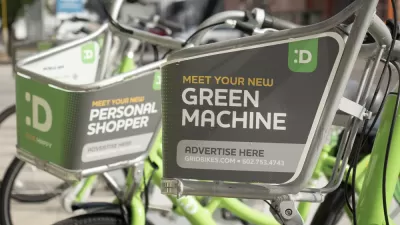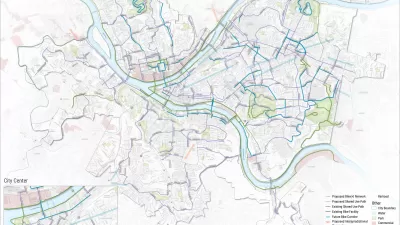The de Blasio administration is offering a parting gift to the city's cyclists.

New York City Mayor Bill de Blasio used the occasion of his final State of the City speech last week to announce plans to remove a vehicle lane on two of the city's bridges to make space for new bike lanes.
Emma G. Fitzsimmons and Winnie Hu report on the nascent plans to add bike lanes on both the Brooklyn Bridge and the Queensboro Bridge in a plan that the mayor is calling "Bridge for the People."
According to the article, the announcement is the latest victory of bike advocates in New York during de Blasio's time in office. "During the mayor’s tenure, city transportation officials have built more than 120 miles of protected bike lanes as part of the city’s efforts to create 1,375 miles of bike lanes, creating the largest urban network in the nation," write Fitzsimmons and Hu.
The article includes the early engineering proposals for each of the bike lanes. On the Brooklyn Bridge, a two-way bike lane would be added to a vehicle lane on the Manhattan-bound since of the bridge. "The existing promenade area at the center of the bridge, which is elevated above the car lanes, will be used only by pedestrians. Cyclists will no longer be able to ride on the promenade, where there is currently a bike lane," according to the article.
On the Queensboro Bridge, the plan would convert the northern outer roadway of the Queensboro Bridge into a two-way bike lane. "The southern outer roadway, which is currently used by Queens-bound cars, will be reconfigured as a pedestrian walkway."
FULL STORY: Car Lanes to Become Bike Lanes on 2 Major New York City Bridges

Trump Administration Could Effectively End Housing Voucher Program
Federal officials are eyeing major cuts to the Section 8 program that helps millions of low-income households pay rent.

Planetizen Federal Action Tracker
A weekly monitor of how Trump’s orders and actions are impacting planners and planning in America.

Ken Jennings Launches Transit Web Series
The Jeopardy champ wants you to ride public transit.

Washington Legislature Passes Rent Increase Cap
A bill that caps rent increases at 7 percent plus inflation is headed to the governor’s desk.

From Planning to Action: How LA County Is Rethinking Climate Resilience
Chief Sustainability Officer Rita Kampalath outlines the County’s shift from planning to implementation in its climate resilience efforts, emphasizing cross-departmental coordination, updated recovery strategies, and the need for flexible funding.

New Mexico Aging Department Commits to Helping Seniors Age ‘In Place’ and ‘Autonomously’ in New Draft Plan
As New Mexico’s population of seniors continues to grow, the state’s aging department is proposing expanded initiatives to help seniors maintain their autonomy while also supporting family caregivers.
Urban Design for Planners 1: Software Tools
This six-course series explores essential urban design concepts using open source software and equips planners with the tools they need to participate fully in the urban design process.
Planning for Universal Design
Learn the tools for implementing Universal Design in planning regulations.
Heyer Gruel & Associates PA
Ada County Highway District
Institute for Housing and Urban Development Studies (IHS)
City of Grandview
Harvard GSD Executive Education
Toledo-Lucas County Plan Commissions
Salt Lake City
NYU Wagner Graduate School of Public Service





























